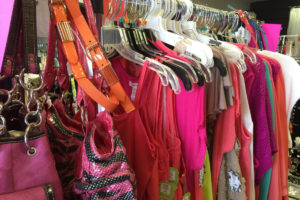 What is shrink? Obviously, that will depend on the context in which you are referencing it. It may be what happens when we wash a new pair of jeans in hot water. Maybe it is what happens to our household budget when our children get older and require more food, clothing, and school supplies. In retail, it has a different meaning altogether. Shrink is not a downsizing of a store or reduction of staff (although it can lead to those things if not addressed). Retail shrink is merchandise we cannot account for due to any number of reasons. It impacts the profit margin of a store and since those losses directly affect the retailer there are usually steps the store owner takes to try to offset those lost dollars. If not well thought out those measures the store owner takes could hurt the business further. There is a vicious circle that follows and can lead to a store closing down.
What is shrink? Obviously, that will depend on the context in which you are referencing it. It may be what happens when we wash a new pair of jeans in hot water. Maybe it is what happens to our household budget when our children get older and require more food, clothing, and school supplies. In retail, it has a different meaning altogether. Shrink is not a downsizing of a store or reduction of staff (although it can lead to those things if not addressed). Retail shrink is merchandise we cannot account for due to any number of reasons. It impacts the profit margin of a store and since those losses directly affect the retailer there are usually steps the store owner takes to try to offset those lost dollars. If not well thought out those measures the store owner takes could hurt the business further. There is a vicious circle that follows and can lead to a store closing down.
In Retail Loss Prevention we generally identify four primary causes of shrink, shoplifting, employee theft, vendor shortage/fraud and administrative errors. According to the 2017 National Retail Security Survey, approximately 66.5% of shrink is attributable to shoplifting and employee theft combined. 21.3% of shrink is due to administrative and paperwork errors, 5.4% is related to vendor fraud or error and 6.8% was unknown (pg. 8). The same report states that the average retail shrink rate in the U.S. was 1.44% in 2017 (pg. 6). Since this is an average that means there are industry sectors that are higher and others that are a bit lower so where your store may fall can depend on what you sell.
What mistakes do retailers make when trying to cover the profit losses from shrink? Often they increase prices on merchandise. Those price changes may be a few cents per item or a few dollars but no matter how small the increase regular customers notice those hikes. There comes a point when customer loyalty takes a backseat to customer’s budgets. No matter how minute you may feel a price increase is there is a threshold that customers will finally say enough is enough and they relent and shop at a big box retail store. Some store owners will make up for the lost revenue through reduced payrolls. This may include getting rid of full-time positions and making them part-time positions saving on benefit expenses. Employee hours may be reduced all around with the store owner picking up more of the workload themselves. The impact of this strategy is a blow to employee morale and loyalty. It can also lead to increased employee theft as those employees feel the financial pinch of the reduced hours and feel cheated. Reduced employee hours also means fewer people on the salesfloor providing customer service which results in more shoplifting, ergo more shrink. As you can see taking the wrong steps to address shrink can lead to a cycle that is hard to break and can lead to a store shut down.
So if a retailer opts not to raise prices what is the resolution to solving the problem of shrink? Retailers cannot afford to continuously bear the costs of shrink. Assuming over 60% of a store’s shrink is incurred through theft then anti-theft measures are a logical starting point. Sensormatic security systems and tags play a critical role in theft prevention. They are proven to significantly cut into theft related shortage. They also help reduce a portion of administrative shortage. If it is tagged, merchandise overlooked in a shopping cart will activate an alarm and be paid for or returned to the store. Requiring vendors to check in and out of the store on a sign in sheet and making them talk to a manager about what they have done that day holds them accountable. Store managers should be doing weekly reviews of vendor credits to ensure they are not losing money for product removed from the store.
Shrink can cut into your profit margin and if that isn’t bad enough addressing it improperly can make the situation for your store worse. Taking positive steps to address each of the areas where losses occur will improve shortage results. It will make you, your employees and your customers happier when your actions are directed towards the real culprits of shortage.
 The retail industry loses an approximate $45 billion a year due to shoplifting, organized retail crime, merchant, and clerical errors. For the small retail owner, any loss due to shoplifting puts a financial strain on their ability to do business, hire more personnel or invest and grow their business.
The retail industry loses an approximate $45 billion a year due to shoplifting, organized retail crime, merchant, and clerical errors. For the small retail owner, any loss due to shoplifting puts a financial strain on their ability to do business, hire more personnel or invest and grow their business. How many times have you caught yourself in a conversation with another manager or a supervisor discussing a seasonal merchandise question or an inventory preparation question and found yourself saying, “I think we did it this way” or “ It seems to me customers were buying such and such last year”? It can be frustrating, especially when the discussion may influence whether an item should be carried or if it was carried the prior year was it a flop? The same thing happens with inventory. Did we start prepping 5 days out? No? Maybe it was 3 days out. Having checklists can make these conversations fewer in number and improve productivity as well as sales performance.
How many times have you caught yourself in a conversation with another manager or a supervisor discussing a seasonal merchandise question or an inventory preparation question and found yourself saying, “I think we did it this way” or “ It seems to me customers were buying such and such last year”? It can be frustrating, especially when the discussion may influence whether an item should be carried or if it was carried the prior year was it a flop? The same thing happens with inventory. Did we start prepping 5 days out? No? Maybe it was 3 days out. Having checklists can make these conversations fewer in number and improve productivity as well as sales performance.
 We supply and install the best anti-shoplifting equipment made. Checkpoint Systems is the gold standard of Electronic Article Surveillance (EAS) equipment. Support is off the chart. Checkpoint Systems has factory Tech’s everywhere, I mean EVERYWHERE. They have to since the majority of the top retailers in the world are using Checkpoint equipment. These Techs are not sub-contractors. They are skilled EAS, Radio Frequency (RF) experts. As an example, my Sr. Tech Dan is a former Navy Electronics Technician; he worked on highly advanced systems that protect our country.
We supply and install the best anti-shoplifting equipment made. Checkpoint Systems is the gold standard of Electronic Article Surveillance (EAS) equipment. Support is off the chart. Checkpoint Systems has factory Tech’s everywhere, I mean EVERYWHERE. They have to since the majority of the top retailers in the world are using Checkpoint equipment. These Techs are not sub-contractors. They are skilled EAS, Radio Frequency (RF) experts. As an example, my Sr. Tech Dan is a former Navy Electronics Technician; he worked on highly advanced systems that protect our country. Actions based on good intentions don’t always have good results. One of the most famous of missteps was the Coca-Cola attempt to improve its formula and market “New” Coke. The idea was well-intentioned but the public reception was cool if not outright hostile. According to the website INVESTOPEDIA, “ “Classic Coke” returned to the shelves less than three months after it had been retired.” In the same article, they point out that in 2008 the manufacturer of Motrin found out that there was a problem with the medicine not dissolving properly. Reportedly they did not want to “incur the associated negative publicity, the firm sent out secret shoppers to buy the products off of store shelves, which resulted in a lawsuit in Oregon in 2011.” (“8 Good Intentions With Bad Outcomes”, Lisa Smith, updated December 15, 2017). Laws can have the same problems of unintended consequences, helping one constituency while hurting another.
Actions based on good intentions don’t always have good results. One of the most famous of missteps was the Coca-Cola attempt to improve its formula and market “New” Coke. The idea was well-intentioned but the public reception was cool if not outright hostile. According to the website INVESTOPEDIA, “ “Classic Coke” returned to the shelves less than three months after it had been retired.” In the same article, they point out that in 2008 the manufacturer of Motrin found out that there was a problem with the medicine not dissolving properly. Reportedly they did not want to “incur the associated negative publicity, the firm sent out secret shoppers to buy the products off of store shelves, which resulted in a lawsuit in Oregon in 2011.” (“8 Good Intentions With Bad Outcomes”, Lisa Smith, updated December 15, 2017). Laws can have the same problems of unintended consequences, helping one constituency while hurting another. Reviewing your store policies today and training your employees about the ramification of not following them properly is imperative. The consequences of not following those policies properly are too costly to postpone. Employees, as they are human, try to use shortcuts or in some instances, take the easy way out while doing some chores without thinking it may affect the bottom line at the end of the day. Profits for a store cannot be thought of as profits for the owner only, employment and benefits for the employees are inherently tied to those of the owner. If the owner must close the store for loses, the employees lose as well.
Reviewing your store policies today and training your employees about the ramification of not following them properly is imperative. The consequences of not following those policies properly are too costly to postpone. Employees, as they are human, try to use shortcuts or in some instances, take the easy way out while doing some chores without thinking it may affect the bottom line at the end of the day. Profits for a store cannot be thought of as profits for the owner only, employment and benefits for the employees are inherently tied to those of the owner. If the owner must close the store for loses, the employees lose as well. Inventory in a retail store can offer the management and the loss prevention team a clear picture of whether their efforts are working or they need to modify something entirely different.
Inventory in a retail store can offer the management and the loss prevention team a clear picture of whether their efforts are working or they need to modify something entirely different.  It is hard to believe but summer is almost here! What are you doing about it? As crazy as the question may sound there is a reason I ask. What are you doing that will be different than what you did last summer? Do you know what it was you did to inspire additional sales last year? Maybe you didn’t do anything at all differently. Maybe you added a new piece of summer merchandise to your merchandising strategy. How did that item do in sales? Was it a blockbuster for you? On a similar note, how was the customer foot traffic in your store? Did you see an increase in the number of patrons last summer over the rest of the year? If you aren’t asking the questions then you are probably flying by the seat of your pants and that is not going to be beneficial to you at all. Sales tracking and Customer Counting can assist you in exponentially growing your sales.
It is hard to believe but summer is almost here! What are you doing about it? As crazy as the question may sound there is a reason I ask. What are you doing that will be different than what you did last summer? Do you know what it was you did to inspire additional sales last year? Maybe you didn’t do anything at all differently. Maybe you added a new piece of summer merchandise to your merchandising strategy. How did that item do in sales? Was it a blockbuster for you? On a similar note, how was the customer foot traffic in your store? Did you see an increase in the number of patrons last summer over the rest of the year? If you aren’t asking the questions then you are probably flying by the seat of your pants and that is not going to be beneficial to you at all. Sales tracking and Customer Counting can assist you in exponentially growing your sales.